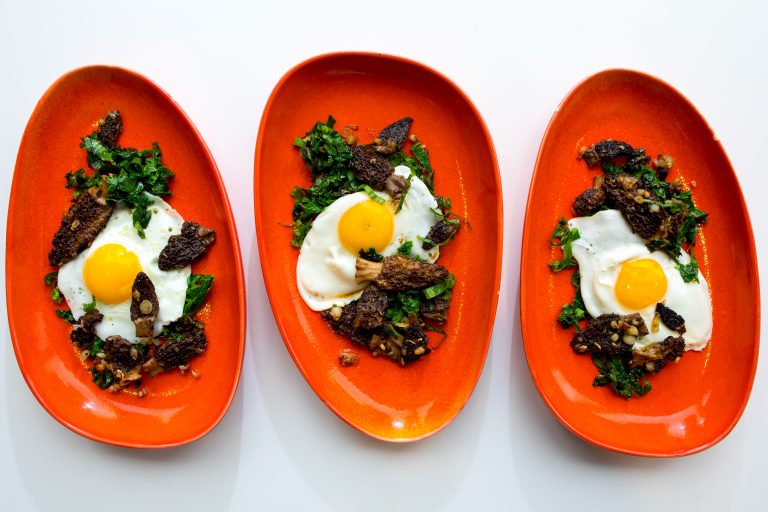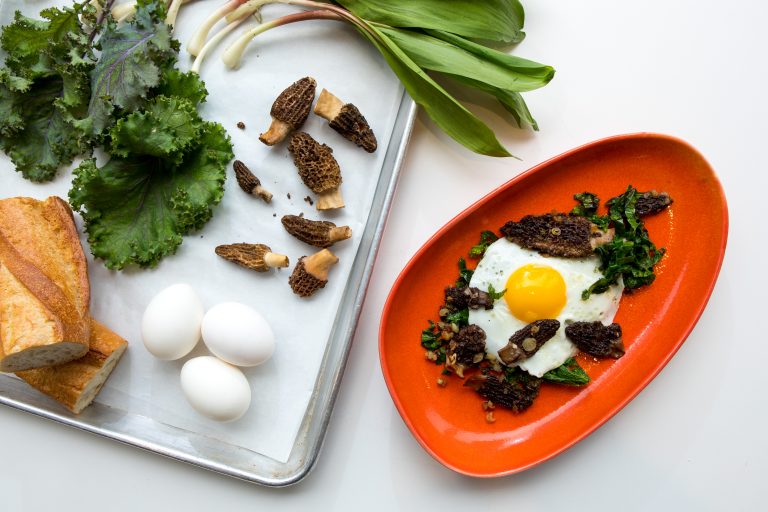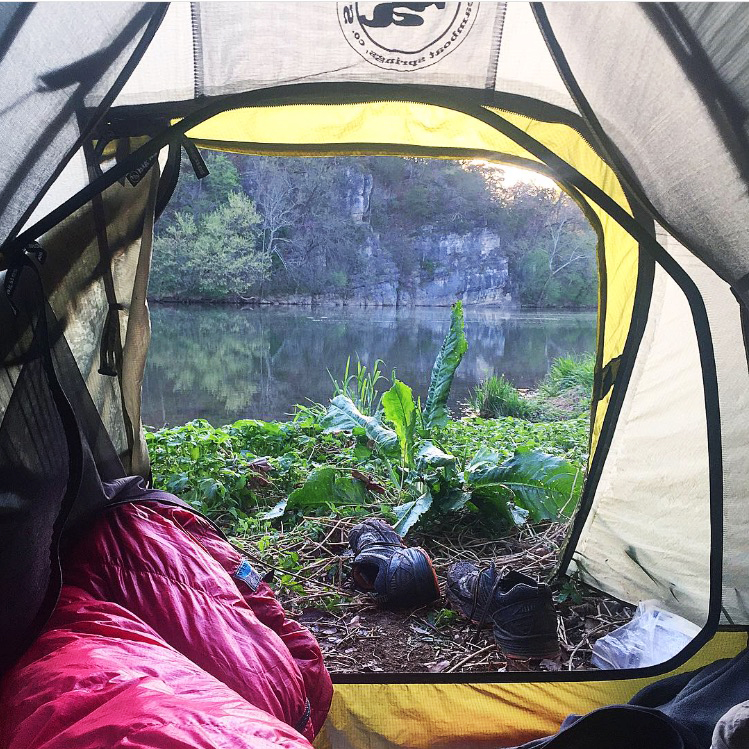Joseph Day is the director of horticulture at Agecroft Hall, a museum in Richmond, Virginia. Previously he ran the historic gardens at George Washington’s estate, Mount Vernon, worked in the gardens of Thomas Jefferson’s Monticello and studied roses at the Brooklyn Botanic Garden. Joseph Day and ICE Chef-Instructor Robert Ramsey are lifelong friends who have been wilderness adventuring together for years. In this blog post, Chef Robert interviews Joseph about one of their favorite shared pastimes.

Drifting slowly downstream, Joseph suddenly yelled out, “Pull over to the right bank — to that small island over there!” We were floating down the meandering, bucolic south fork of the Shenandoah River, not far from the nation's capital. It was an unseasonably warm April day, and the dark storm clouds rolling over the Alleghany highlands made it feel even more like summer.
As we veered our canoe toward the starboard side, my buddy Scott wondered aloud why we were stopping. It turns out Joe had spotted a large crop of garlic mustard, an edible, leafy green plant. While it may have felt like summer on this particular day, these tasty, wild edibles reminded us that it really was April, after all. 
To the untrained eye, it may have looked like just another grove of weeds growing on the forest floor, but for Joseph Day, Scott Parker and myself, it was dinner (and tomorrow's breakfast to boot). The aptly named bitter greens have strong flavors of horseradish, pepper and, of course, garlic and mustard. As the storm clouds rolled in and the rain began to fall, we decided to stay put, harvest some greens and remain under the still-thin leaf cover of the early spring forest.
By the time the storm cleared, we had gathered two hefty grocery bags of freshly picked greens, removed of their grit and sand by the rain. We were satisfied. There is wild food all around us — we just have to stop, look and know what to look for. Foraged foods are pure, fresh, delicious and almost always rewarding. Guided by Joseph, the more experienced forager in the group, we were able to find fresh herbs and produce, full of nutrients and free for the taking, without ever leaving our campsites.
Following this particular adventure, I reminisced with Joseph about our many exploits in nature. We started thinking about ways to share the joys of finding your own food with others. In this Q&A, we tackle some of the key questions that a novice forager might have, and developed a recipe using some of the best wild spring crops that the East Coast has to offer.
Robert: A lot of outdoor enthusiasts are interested in, but afraid of, foraging. Do you have any advice to help people feel at ease eating what they find?
Joseph: My first piece of foraging advice would be: learn the forest. Like fruits and vegetables, foraged foods are ripe only certain times of the year. The rest of the year, the plant is doing something else. Learn the whole life cycle of the plant, from early basal foliage to fruit and seed production. This will give you more confidence in what you are searching for.
How can someone who has never tried foraging get started?
In an ideal world, I would make contact with a local expert who can take the time to explain the life cycle of the best foraging plants. Otherwise, I would start with foraging flowers. The bright colors are easy to spot from your commute or your daily stroll. An example of this would be Cercis canandensis, commonly called eastern redbud. The bright purplish-red flowers are unmistakable and easy to find when quickly scanning the wood line.
Are certain times of the year best for foraging? Can you forage during all seasons?
I forage in all seasons, if not directly for the kitchen then just with my eyes. The dead of winter can be tricky, but if you keep your eyes open you can still find a decent crop. I would recommend early spring for the unguided novice forager. The early spring brings you the simple but flavorful greens and spring tonics that you missed during the winter. Late summer/early fall is when you find big fruit and nut crops which can be a much more substantial meal.
R: There is a common perception that foraging comes with the risk of food poisoning. What can people do to minimize this risk?
Information is key. I have been foraging since my early teens and have never had anything but a delightful meal of the local harvest. I also don’t take risks when it comes to foraging, I am certain in my identification before I harvest. If I am harvesting for a plant that has medicinal value, I consult an expert before I start using it.
What are you favorite foods to find? This can include plants, nuts, seeds, fungus, animals… anything.
I enjoy garlic mustard, passionflower for tea, verbascom for smoking, a good persimmon, pawpaws and the black walnut.
Are there foods/plants that people should avoid — either because they are dangerous, unhealthy or just plain unpleasant to eat?
Like everything else in the produce world, when it comes to harvesting it’s all about timing. Plants become less palatable and lose their freshness and taste profile as they go through their life cycle. For example, dandelions lose their tenderness as they mature, persimmons are almost inedible before the frost and pawpaws have a shelf life of about a day before they become too mushy.
Mushroom hunting is its own specialty. Do foragers need different skills or experience to take on this task?
Mushroom hunting requires much more research and knowledge: it can be dangerous. I would recommend a novice mushroom hunter to do their reading and forage with an expert at first. I also recommend using a mesh bag, like a leftover citrus or onion bag from the grocery store. Using a bag like this when harvesting fungus allows for dispersing spores for the next season.
Hardcore foragers are known for being secretive about the location of their finds. Do you know of any lore or anecdotes about the adventures of a forager?
Near my grandmother’s farm in Sperryville, Virginia, morel hunting was a major pastime in the spring months. There lives a professional morel hunter who searches and sells to local restaurants for top dollar — he starts out before dawn and doubles back to make sure he isn’t followed. These clandestine foragers were envied for their skill set and often accused of trespass.
As a boy, I recall being jealous of their ability to find the best crop and of their knowledge of the land. Most morel hunters are gathering for their own table and are usually happy to share the harvest, but will never tell you where they found the crop. I’ve seen fights and rifts between families. Another anecdote about morel hunting: Very often in Rappahannock County, Virginia they call morels “miracles.” This is because it’s a miracle to find one.
What can an amateur forager expect to find in the New York region this time of year?
Dandelion greens, flowers from the eastern redbud, crest, ramps, violet flowers, garlic mustard.

Sunnyside Eggs Over Sautéed Wild Greens With Morels and Ramps
Yield: serves 4
This recipe is simple and made with plants that are ready to harvest...RIGHT NOW! It's so easy you can make it on your next camping trip — all you have to bring is the eggs and a little butter.
Ingredients:
- 8 high-quality fresh chicken eggs
- 1 pound mixed wild greens (like mustards, chicory, dandelion or watercress)
- 1 small bunch ramps (about 5 or 6)
- 1 pound morel mushrooms (can be purchased, only forage if you are an expert)
- 4 ounces (1 stick) butter
- ¼ cup salt
- Salt and pepper to taste
Preparation:
- Mix the salt with approximately one gallon of water, mix thoroughly and add the morels to soak for one hour.
- While the morels are soaking, carefully wash and dry the wild greens and ramps (in a salad spinner if you have one).
- Cut the greens and the ramp tops (the green, leafy part of the ramps) into a chiffonade, or long, thin strips. Mix together in a large mixing bowl. Reserve the ramp bulbs (the white and pink part at the bottom).
- Remove the morels from the water and use paper towels to gently dry them.
- Returning to the ramp bottoms, remove the furry looking roots, and then mince the rest of the ramp.
- In a large sauté pan, melt half the butter over medium heat. When it begins to bubble and brown, add the morels, a pinch of salt and sauté. If the morels are too wet, they will cool down the pan and you won’t hear any sizzling. If this happens increase the heat of your pan until it sizzles again. Sauté until browned and wilted, about five minutes.
- Add the minced ramp bulbs to the pan. Cook, constantly stirring, until the ramp bulbs turn translucent, about one minute. Add the mixed greens to the pan, another pinch of salt and pepper, and sauté until wilted, another three to four minutes.
- Remove the mixture from the pan and reserve (outside of the refrigerator).
- Reduce heat to medium low and melt the other half of the butter. Crack the eggs into the pan and cook sunny side up to desired doneness, remembering to sprinkle each one with a little salt and pepper. Work in batches if your pan is not large enough to fit all eggs.
- To serve, divide the mushroom and greens mixture between four plates, or just one platter if you’re eating family style. Top with a sunny side up egg and enjoy nature’s bounty!
Want to study the culinary arts with Chef Robert? Click here for more information on ICE’s Culinary Arts program.





